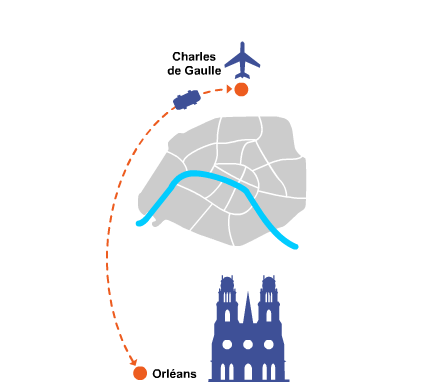Choose your route
Transfer CDG Airport - Orléans

CDG Airport - Orléans
Private car and van transfer to/from CDG Airport to Orleans
| Passengers | 1 - 2 | 4 - 5 | 6 - 7 | Action |
|---|---|---|---|---|
| CDG Airport - Orleans | €290 | €330 | €400 | Book now |
| CDG Airport - Chartres | €220 | €250 | €310 | Book now |
| CDG Airport - Le Mans | €440 | €470 | €620 | Book now |
Travel comfortably with our private transfer from CDG Airport to Orleans, a city full of medieval charm and history. Our professional driver ensures a smooth, timely pickup and personalized assistance for all travelers. Discover Orleans’ wonders like the majestic Sainte-Croix Cathedral and the historic House of Joan of Arc, symbols of France’s rich past. Sit back and enjoy a peaceful ride with a service that values punctuality and comfort above all. To better organize your transfer, consult our helpful airport transfer guide that answers all common questions. Relax knowing that your dedicated driver will meet you at the terminal with a customized sign, ensuring an easy start to your French journey to Orleans.
For those heading toward Chartres, our private transportation service offers the same high standards, ensuring a seamless trip from CDG Airport to this remarkable city. Chartres is home to the incredible Chartres Cathedral, a UNESCO World Heritage Site, and the charming Old Town with its cobbled streets. During the journey, appreciate a personalized, safe experience free from the stress of public transport. Trust our company to make your travel effortless, secure, and comfortable. Check our competitive prices for different destinations on this full airport transfer prices page. Enjoy a tailor-made journey adapted to your personal needs between Paris airports and iconic cities.
Book a private shuttle transfer from Charles de Gaulle Airport to Orléans
- History of Orleans
- Orleans nowadays
- What to visit in Orleans ?
- Discover the Groslot Hotel in Orleans
- What to see in the Museum of Fine Arts of Orléans ?
- Request a car service in Paris to go to Orleans


















